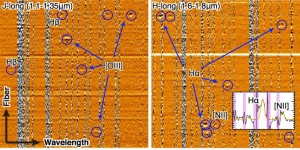Marching to the Beat Well-Orchestrated Growth of Massive Galaxies in the Early Universe

An international team of astronomers including John Silverman, Assistant Professor at the Kavli Institute for the Physics and Mathematics of the Universe (Kavli IPMU), the University of Tokyo, participating in the Cosmological Evolution Survey (COSMOS), has found that galaxies, ten billion years ago, provided a nurturing environment for the birth of new stars at remarkable rates while at the same time as orderly as commuters on a typical Tokyo workday. Even at these early times, there are signs of maturation, since the surroundings of massive galaxies were relatively dusty and enriched by heavier elements. These findings center on a major question: What was the Universe like when stars were being formed at maximum rate?

© FMOS-COSMOS, FMOS spectra in the J-band (1.1-1.35 μm, left panel) and H-band (1.6-1.8 μm, right panel), each of which filters light so that only specific wavelengths can pass through. The horizontal axis refers to the wavelength direction while the vertical axis indicates individual spectra observed through each fiber (spectra from 68 fibers are shown). Small blue circles indicate the detection of emission lines. The inset box shows the intensity of the emission lines for one galaxy. The vertical bands indicate the masked regions where bright sky (hydroxyl, OH) emissions are prevented from entering science fibers placed on high-redshift galaxies.
This research uses the Fiber-Multi-Object Spectrograph (FMOS) mounted on the Subaru Telescope to map the distribution of over 1,000 galaxies as part of a project to create a map of the Universe of ten billion years ago. Creating such a map will help us understand the role of the environment of large-scale structures in how the early Universe developed into the Universe we inhabit today.
Paper
D. Kashino, J. D. Silverman, G. Rodighiero et al.,
“The FMOS-Cosmos Survey of Star-Forming Galaxies at z~1.6 I. Hα-Based Star Formation Rates and Dust Extinction”,
The Astrophysical Journal Letters volume 777, L8 (2013), doi: 10.1088/2041-8205/777/1/L8.
Article link
Links
Kavli Institute for the Physics and Mathematics of the Universe
Past press release (Japanese)






